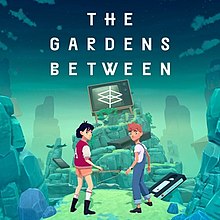
Sonic Drift is a 1994 racing game based on Sonic the Hedgehog developed and published by Sega for the Game Gear. Players control one of four characters as they race to the finish line, with 18 tracks themed after levels in 1991's Sonic the Hedgehog.

Lumines: Puzzle Fusion is a 2004 puzzle game developed by Q Entertainment and published for the PlayStation Portable by Bandai in Japan and by Ubisoft elsewhere. The objective of the game is to arrange descending two-colored 2×2 blocks to create 2×2 squares of matching color. A vertical line known as the "time line" sweeps across the field, erases completed squares, and awards points. Each stage has a skin that affects the background, block colors, music, and the speed of the time line.
Eurogamer is a British video game journalism website launched in 1999 alongside parent company Gamer Network.

Pac-Attack, also known as Pac-Panic, is a 1993 falling-tile puzzle video game developed and published by Namco for the Super Nintendo Entertainment System and Sega Genesis. Versions for the Game Boy, Game Gear and Philips CD-i were also released. The player is tasked with clearing out blocks and ghosts without them stacking to the top of the playfield — blocks can be cleared by matching them in horizontal rows, while ghosts can be cleared by placing down a Pac-Man piece that can eat them. It is the first game in the Pac-Man series to be released exclusively for home platforms.

Tetris Effect is a block-dropping arcade-styled puzzle video game developed by Japanese studios Monstars and Resonair and published by Enhance Games. The game was released worldwide exclusively for the PlayStation 4 on November 9, 2018, and features support for the PlayStation VR. A Microsoft Windows version, with support for Oculus Rift and HTC Vive, was released on July 23, 2019. A version for the Meta Quest standalone VR headset was released on May 14, 2020.

The Legend of Zelda: Breath of the Wild is a 2017 action-adventure game developed and published by Nintendo for the Nintendo Switch and Wii U. Set at the end of the Zelda timeline, the player controls an amnesiac Link as he sets out to save Princess Zelda and prevent Calamity Ganon from destroying the world. Players explore the open world of Hyrule while they collect items and complete objectives such as puzzles or side quests. Breath of the Wild's world is unstructured and encourages exploration and experimentation; the story can be completed in a nonlinear fashion.

Dr. Luigi is a 2013 puzzle video game developed by Arika and Nintendo SPD, and published by Nintendo for the Wii U console. It is the sixth game in the Dr. Mario series and is part of the larger Mario franchise. The player must clear a field of invading viruses using pill capsules to eliminate them, in a tile-matching fashion. The game offers four modes: "Operation L", which utilizes L-shaped pills; "Virus Buster", using the Wii U GamePad and touchscreen; "Retro Remedy" with standard Dr. Mario gameplay; and local and online multiplayer options, online utilizing the soon to be defunct Nintendo Network Service.
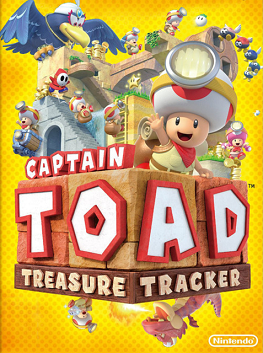
Captain Toad: Treasure Tracker is a 2014 action puzzle video game developed and published by Nintendo for the Wii U. The game was re-released for the Nintendo Switch and Nintendo 3DS in 2018 with additional content. It is a spin-off of the Super Mario series and a part of the larger Mario franchise. The game stars Captain Toad and Toadette as they complete levels and save each other from the antagonist Wingo. Each level is contained within a miniature diorama-like environment that requires puzzle-solving and platforming challenges to complete. The player also uses the Wii U GamePad to rotate the camera and reveal new information and interact with the environment.
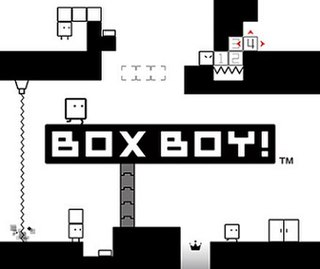
BoxBoy! is a puzzle-platform game developed by HAL Laboratory and published by Nintendo for the Nintendo 3DS handheld console. Players control Qbby, a square-shaped character who can produce a string of connected boxes. The boxes are used to overcome obstacles in stages that Qbby must be guided through. The project plan for BoxBoy! was devised in 2011 by director Yasuhiro Mukae, although the game did not enter development until 2013. The core gameplay concept remained the same throughout the title's development, however, changes were made to length of levels and the structure of the game. Each set of stages was designed with a specific theme in mind with the intention of expanding the game's depth by introducing new elements continuously. The game was released via the Nintendo eShop distribution service in Japan in January 2015, and worldwide in April 2015.

Celeste is a 2018 platform game developed and published by indie studio Maddy Makes Games. The player controls Madeline, a young woman with anxiety and depression who aims to climb Celeste Mountain. During her climb, she encounters several characters, including a personification of her self-doubt known as Badeline, who attempts to stop her from climbing the mountain.

Sabre Wulf is a 2004 video game by Rare for the Game Boy Advance. The player controls the safari adventurer Sabreman, who runs and jumps between platforms to retrieve treasure guarded by the Sabre Wulf. The game is a remake of the 1984 action-adventure Sabre Wulf. Though remake's reviews were generally favourable, sales were lackluster. Reviewers noted the game's simplicity and shallow puzzles. While some found it fun and praised its character animations, reviewers considered its gameplay repetitive.
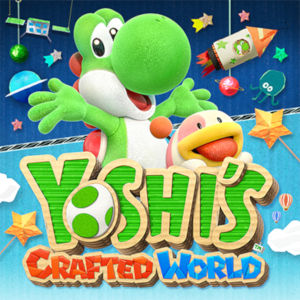
Yoshi's Crafted World is a platform video game developed by Good-Feel and published by Nintendo for the Nintendo Switch. The eighth main installment in the Yoshi franchise, it is the spiritual successor to Yoshi's Woolly World. The game was revealed at E3 2017, and was released worldwide on March 29, 2019. It follows the Yoshis as they venture to collect the scattered gems of the Sundream Stone, which has the ability to grant wishes, before Kamek and Baby Bowser can.
Paper Mario is a video game series and part of the Mario franchise, developed by Intelligent Systems and produced by Nintendo. It combines elements from the role-playing, action-adventure, and puzzle genres. Players control a paper cutout version of Mario, usually with allies, on a quest to defeat the antagonist, primarily Bowser. The series consists of six games and one spin-off; the first, Paper Mario (2000), was released for the Nintendo 64, and the most recent, Paper Mario: The Origami King (2020), for the Nintendo Switch.

The Messenger is a 2018 action-platform game created by indie developer Sabotage Studio and published by Devolver Digital. The player controls the eponymous ninja, who is appointed by a great hero to deliver a scroll. As the Messenger explores levels and defeats enemies, he gains a currency called Time Shards used to purchase useful upgrades and abilities. The game begins as a linear adventure featuring elements of time travel, with the audio and visuals changing from an 8-bit style to 16-bit to represent the ninja's journey from the past to the future. In the second half, The Messenger becomes a Metroidvania-style game where the player revisits previous levels to find key items.

Hitman 2 is a 2018 stealth video game developed by IO Interactive. It is the seventh main installment in the Hitman video game series, the sequel to 2016's Hitman and the second game in the World of Assassination trilogy. The game continues the story arc started in Hitman, following genetically engineered assassin Agent 47 as he searches for the mysterious "Shadow Client" who is trying to destroy Providence, a secretive organization that controls global affairs. It also explores more of 47's mysterious background, which Providence offered to bring to light in exchange for 47's assistance. Like its predecessor, the game is structured around six large sandbox locations that players can freely explore to find opportunities to eliminate their targets. It also included two online multiplayer modes called Sniper Assassin and Ghost Mode, though the game's servers for both modes have since been shut down; Sniper Assassin can still be played single-player.

Star Wars Jedi: Fallen Order is a 2019 action-adventure game developed by Respawn Entertainment and published by Electronic Arts. The story is set in the Star Wars universe, five years after Star Wars: Episode III – Revenge of the Sith. It follows Jedi Padawan Cal Kestis, who becomes a target of the Galactic Empire and is hunted throughout the galaxy by the Imperial Inquisitors while attempting to complete his training, reconcile with his troubled past, and rebuild the fallen Jedi Order. The player can use Kestis' lightsaber and Force powers to defeat enemies, including stormtroopers, wild beasts and bounty hunters. The game adopts a Metroidvania style of level design where new areas are accessed as Cal unlocks skills and abilities.

Overcooked 2 is a cooperative cooking simulation video game developed by Team17 alongside Ghost Town Games, and published by Team17. The sequel to Overcooked!, it was released for Linux, macOS, Nintendo Switch, PlayStation 4, Windows, and Xbox One on August 7, 2018. The game was released for Amazon Luna on October 20, 2020. Overcooked: All You Can Eat, a compilation game that includes both Overcooked and Overcooked 2, was released for PlayStation 5 and Xbox Series X/S on November 12, 2020. The compilation came to Nintendo Switch, PlayStation 4, Windows, and Xbox One on March 23, 2021, and on Google Stadia on May 5, 2022.
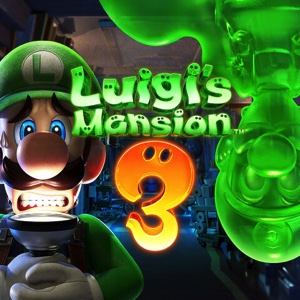
Luigi's Mansion 3 is a 2019 action-adventure video game developed by Next Level Games and published by Nintendo for the Nintendo Switch. It is the third installment in the Luigi's Mansion series following Luigi's Mansion: Dark Moon. The game sees players taking on the role of Luigi who must explore a haunted hotel, incorporating different themes on each floor, and save his friends from the ghosts that inhabit it, after the group is tricked into visiting it for a vacation by King Boo.

Baba Is You is a puzzle video game created by Finnish independent developer Arvi Teikari. Originating as a short demo built for the 2017 Nordic Game Jam, the game was expanded and released on 13 March 2019 for PC and Nintendo Switch. Mobile versions were released in June 2021. The game centers around the manipulation of "rules"—represented in the play area by movable tiles with words written on them—in order to allow the player character, usually the titular Baba, to reach a specified goal. A free update titled "Baba Make Level" was released on November 17, 2021, featuring over 150 new and previously unused levels and a level editor with online sharing.

Teardown is a 2022 sandbox–puzzle game developed and published by Tuxedo Labs. The game revolves around the owner of a financially stricken demolition company, who is caught executing a questionable job and becomes entangled between helping police investigations and taking on further dubious assignments. Teardown features levels made of destructible voxels, and the player follows the campaign through consecutive missions. In most missions, the player must collect or destroy objects connected to a security alarm. The player has unlimited time to prepare and is given upgradable tools, vehicles, and explosives to create a path within the level that allows them to complete the objectives as quickly as possible. A timer starts as soon as the security alarm is triggered, and the player must complete all required objectives and reach a getaway vehicle within sixty seconds.
